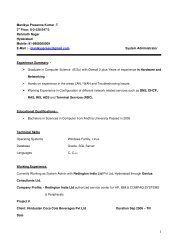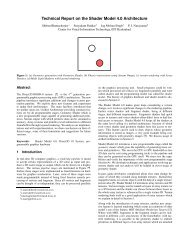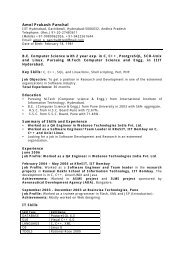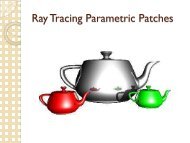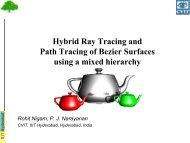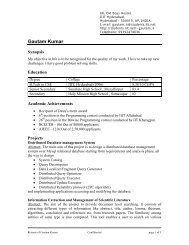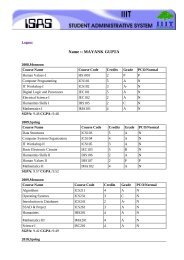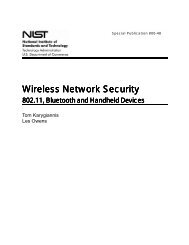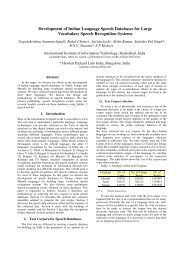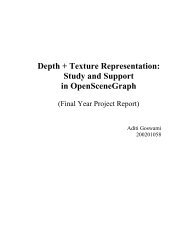Modeling Letter to Phoneme Conversion as a Phrase Based ...
Modeling Letter to Phoneme Conversion as a Phrase Based ...
Modeling Letter to Phoneme Conversion as a Phrase Based ...
- No tags were found...
Create successful ePaper yourself
Turn your PDF publications into a flip-book with our unique Google optimized e-Paper software.
phoneme sequence among the candidate translationscan be represented <strong>as</strong>:ˆf = arg max {Pr (f | l)} (1)fWe model the problem of letter <strong>to</strong> phoneme conversionb<strong>as</strong>ed on the noisy channel model. Reformulatingthe above equation using Bayes Rule:f best = arg max p(l | f) p (f) (2)fThis formulation allows for a phoneme n-grammodel p (f) and a transcription model p (l | f). Givena sequence of letters l, the argmax function is <strong>as</strong>earch function <strong>to</strong> output the best phonemic sequence.During the decoding ph<strong>as</strong>e, the letter sequencel is segmented in<strong>to</strong> a sequence of J letter segments¯l J1 . Each segment ¯lj in ¯l J1 is transcribed in<strong>to</strong>a phoneme segment ¯f j . Thus the best phoneme sequenceis generated from left <strong>to</strong> right in the form ofpartial translations. By using an n-gram model p LM<strong>as</strong> the language model, we have the equations:f best = arg max p(l | f) p LM (3)fwith p (l | f) written <strong>as</strong>p(¯l J 1 | ¯f J 1 ) =J∏Φ(¯l j | ¯f j) (4)j=1From the above equation, the best phoneme sequenceis obtained b<strong>as</strong>ed on the product of the probabilitiesof transcription model and the probabilitiesof a language model and their respective weights.The method for obtaining the transcription probabilitiesis described briefly in the next section. Determiningthe best weights is necessary for obtainingthe right phoneme sequence. The estimation of themodels’ weights can be done in the following manner.The posterior probability Pr (f | l) can be directlymodeled using a log-linear model. In this model,we have a set of M feature functions h m (f, l), m =1...M . For each feature function there exists aweight or model parameter λ m , m = 1...M. Thusthe posterior probability becomes:p (f | l) = p λ M1(f | l) (5)The above modeling entails finding the suitablemodel parameters or weights which reflect the propertiesof our t<strong>as</strong>k. We adopt the criterion followedin (Och, 2003) for optimising the parameters of themodel. The details of the solution and proof for theconvergence are given in Och(Och, 2003). The models’weights used for the L2P t<strong>as</strong>k are obtained fromthis training.4 <strong>Letter</strong> <strong>to</strong> <strong>Phoneme</strong> AlignmentWe used GIZA++ (Och and Ney, 2003), an opensource <strong>to</strong>olkit, for aligning the letters with thephonemes in the training data sets. In the contex<strong>to</strong>f SMT, say English-Spanish, the parallel corpus isaligned bidirectionally <strong>to</strong> obtain the two alignments.The IBM models give only one-<strong>to</strong>-one alignmentsbetween words in a sentence pair. So, GIZA++ usessome heuristics <strong>to</strong> refine the alignments (Och andNey, 2003).In our input data, the source side consists ofgrapheme (or letter) sequences and the target sideconsists of phoneme sequences. Every letter orgrapheme is treated <strong>as</strong> a single ‘word’ for theGIZA++ input. The transcription probabilities canthen be e<strong>as</strong>ily learnt from the alignments inducedby GIZA++, using a scoring function (Koehn et al.,2003). Figure 1 shows the alignments induced byGIZA++ for the example words which are mentionedby Jiampojamarn et al (Jiampojamarn et al.,2007). In this figure, we only show the alignmentsfrom graphemes <strong>to</strong> phonemes.Figure 1: Example Alignments from GIZA++5 EvaluationWe have evaluated our models on the EnglishCMUDict, French Brulex, German Celex andDutch Celex speech dictionaries. These dictionariesare available for download on the websiteof PROANALSYL 1 <strong>Letter</strong> <strong>to</strong> <strong>Phoneme</strong> <strong>Conversion</strong>1 http://www.p<strong>as</strong>cal-network.org/Challenges/PRONALSYL/
ReferencesSusan Bartlett, Grzegorz Kondrak, and Colin Cherry.2008. Au<strong>to</strong>matic syllabification with structured SVMsfor letter-<strong>to</strong>-phoneme conversion. In Proceedings ofACL-08: HLT, pages 568–576, Columbus, Ohio, June.ACL.Max Bisani and Hermann Ney. 2002. Investigationson joint-multigram models for grapheme-<strong>to</strong>-phonemeconversion. In International Conference on SpokenLanguage Processing, pages 105–108, Denver, CO,USA, September.A.W. Black, K. Lenzo, and V. Pagel. 1998. Issues inBuilding General <strong>Letter</strong> <strong>to</strong> Sound Rules. In The ThirdESCA/COCOSDA Workshop (ETRW) on Speech Synthesis.ISCA.M. Collins. 2002. Discriminative training methods forhidden Markov models: theory and experiments withperceptron algorithms. In Proceedings of the ACL-02conference on EMNLP-Volume 10, pages 1–8. ACL,Morris<strong>to</strong>wn, NJ, USA.K. Crammer and Y. Singer. 2003. Ultraconservative onlinealgorithms for multicl<strong>as</strong>s problems. The Journalof Machine Learning Research, 3:951–991.W.N.I.P. Daelcnians, P. Antal, and J. van denBosch. 1997. Language-Independent Data-0rientedGrapheme-<strong>to</strong>-<strong>Phoneme</strong> <strong>Conversion</strong>. Progress inSpeech Synthesis.R.I. Damper, Y. Marchand, J.D. Marseters, and A. Bazin.2004. Aligning <strong>Letter</strong>s and <strong>Phoneme</strong>s for Speech Synthesis.In Fifth ISCA Workshop on Speech Synthesis.ISCA.Sittichai Jiampojamarn, Grzegorz Kondrak, and TarekSherif. 2007. Applying many-<strong>to</strong>-many alignmentsand hidden markov models <strong>to</strong> letter-<strong>to</strong>-phoneme conversion.In HLT 2007: The Conference of the NAACL;Proceedings of the Main Conference, pages 372–379,Rochester, New York, April. ACL.Sittichai Jiampojamarn, Colin Cherry, and GrzegorzKondrak. 2008. Joint processing and discriminativetraining for letter-<strong>to</strong>-phoneme conversion. In Proceedingsof ACL-08: HLT, pages 905–913, Columbus,Ohio, June. ACL.P. Koehn, F.J. Och, and D. Marcu. 2003. Statisticalphr<strong>as</strong>e-b<strong>as</strong>ed translation. In Proceedings of the 2003Conference of the NAACL:HLT-Volume 1, pages 48–54. ACL Morris<strong>to</strong>wn, NJ, USA.P. Koehn, H. Hoang, A. Birch, C. Callison-Burch,M. Federico, N. Ber<strong>to</strong>ldi, B. Cowan, W. Shen,C. Moran, R. Zens, et al. 2007. Moses: Open SourceToolkit for Statistical Machine Translation. In ACL,volume 45, page 2.J. Kominek and A.W. Black. 2006. Learning pronunciationdictionaries: language complexity and word selectionstrategies. In HLT-NAACL, pages 232–239. ACL,Morris<strong>to</strong>wn, NJ, USA.Y. Marchand and R.I. Damper. 2000. A MultistrategyApproach <strong>to</strong> Improving Pronunciation by Analogy.Computational Linguistics, 26(2):195–219.F.J. Och and H. Ney. 2003. A Systematic Comparison ofVarious Statistical Alignment Models. ComputationalLinguistics, 29(1):19–51.F.J. Och. 2003. Minimum error rate training in statisticalmachine translation. In Proceedings of the 41st AnnualMeeting on ACL-Volume 1, pages 160–167. ACL,Morris<strong>to</strong>wn, NJ, USA.J. Schroeter, A. Conkie, A. Syrdal, M. Beutnagel,M. Jilka, V. Strom, Y.J. Kim, H.G. Kang, and D. Kapilow.2002. A Perspective on the Next Challenges forTTS Research. In IEEE 2002 Workshop on SpeechSynthesis.Tarek Sherif and Grzegorz Kondrak. 2007. Substringb<strong>as</strong>edtransliteration. In Proceedings of the 45th AnnualMeeting of the Association of ComputationalLinguistics, pages 944–951, Prague, Czech Republic,June. Association for Computational Linguistics.A. S<strong>to</strong>lcke. 2002. Srilm – an extensible language modeling<strong>to</strong>olkit.P. Taylor. 2005. Hidden Markov Models for Grapheme<strong>to</strong> <strong>Phoneme</strong> <strong>Conversion</strong>. In Ninth European Conferenceon Speech Communication and Technology.ISCA.K. Toutanova and R.C. Moore. 2002. Pronunciationmodeling for improved spelling correction. In Proceedingsof the 40th annual meeting of ACL, pages144–151.A. van den Bosch and S. Canisius. 2006. Improvedmorpho-phonological sequence processing with constraintsatisfaction inference. In Proceedings of theEighth Meeting of the ACL-SIGPHON at HLT-NAACL,pages 41–49.A. van den Bosch and W. Daelemans. 1998. Do not forget:Full memory in memory-b<strong>as</strong>ed learning of wordpronunciation. proceedings of NeMLap3/CoNLL98,pages 195–204.R. Zens and H. Ney. 2004. Improvements in phr<strong>as</strong>eb<strong>as</strong>edstatistical machine translation. In HLT Conf. /NAACL, pages 257–264, Bos<strong>to</strong>n, MA, May.



